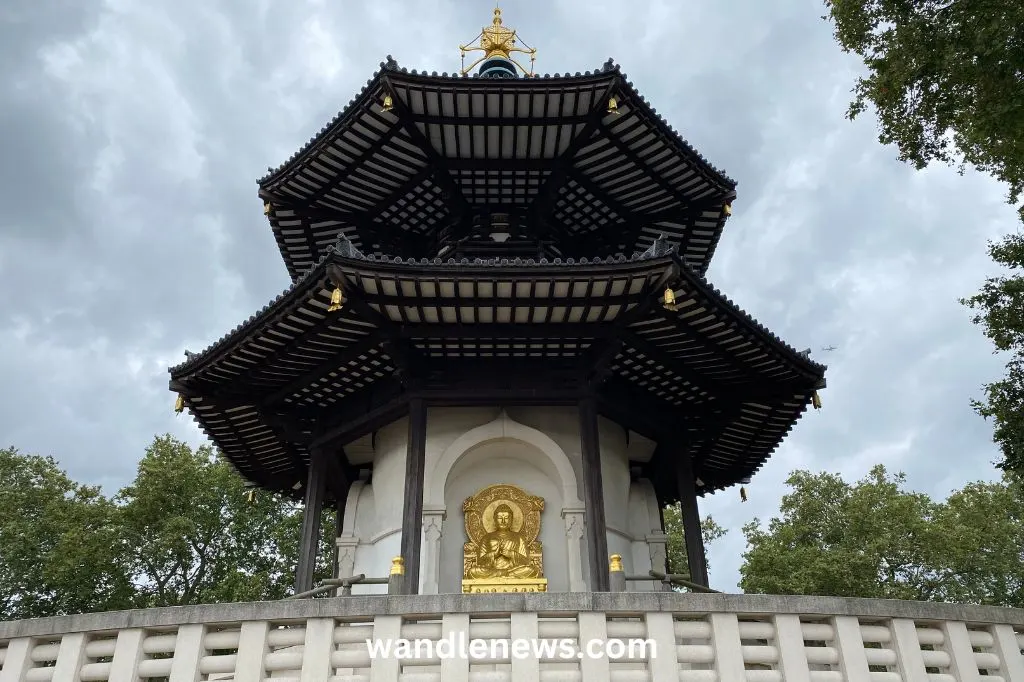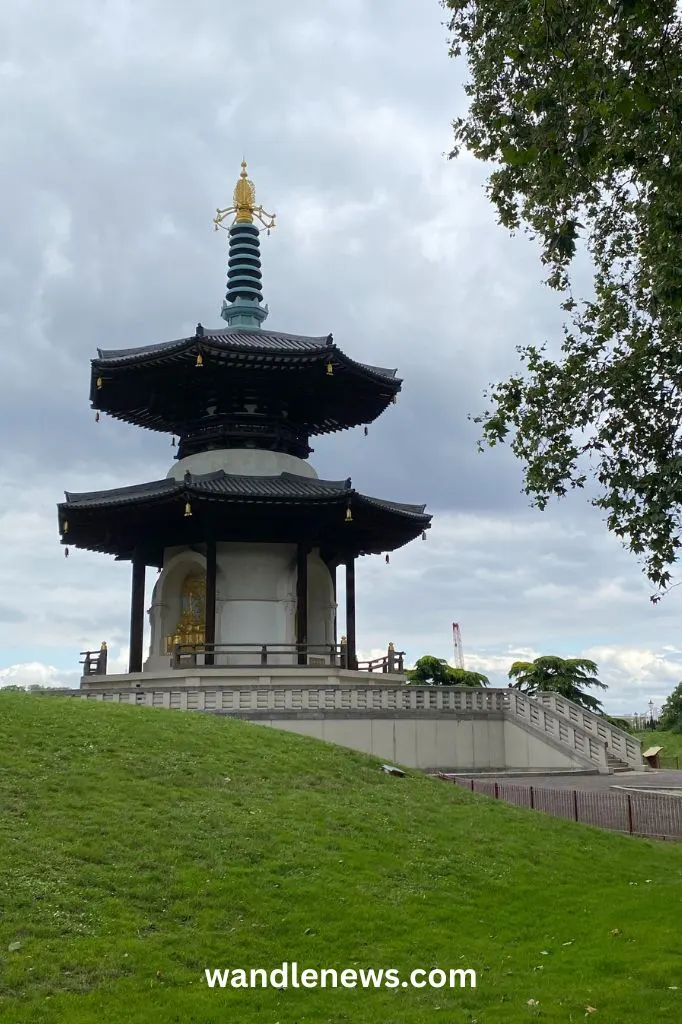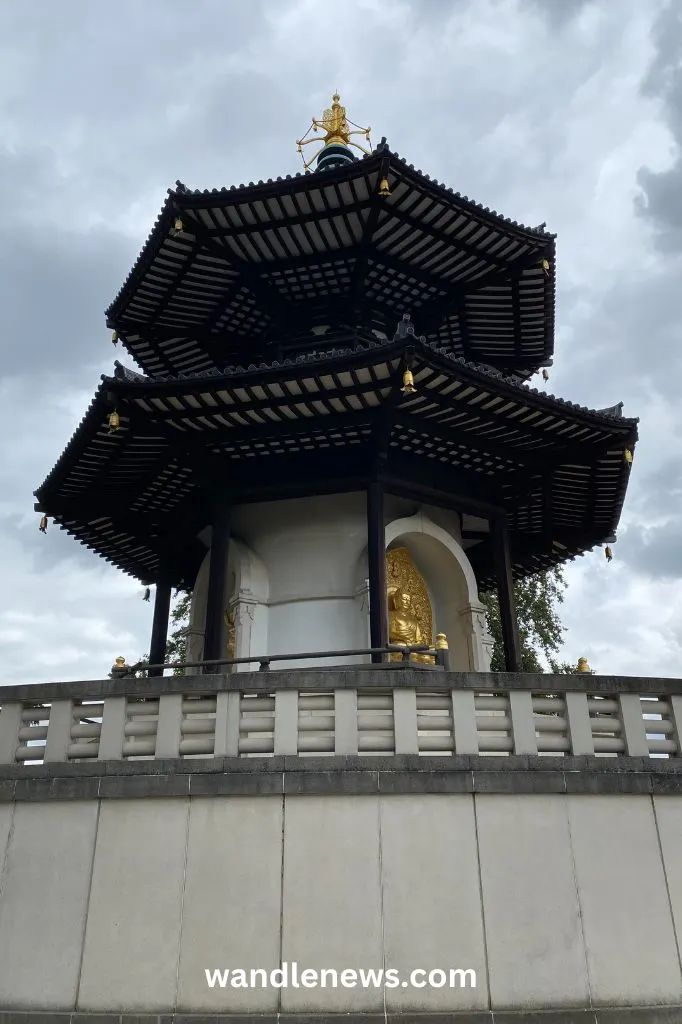The London Peace Pagoda in Battersea Park was gifted to the city of London in 1985, by the Nipponzan Myohoji Buddhist order in Japan. It is one of more than 80 peace pagodas around the world that were built between 1947 and 2000, after the atomic bombing of Hiroshima and Nagasaki. The pagodas were built as shrines to peace, compassion, and nonviolence.
This post is about the London Peace Pagoda in Battersea Park, including its annual events and history.

What is the London Peace Pagoda?
The London Peace Pagoda is a Buddhist monument located in Battersea Park, next to the river Thames.
The pagoda is a traditional Buddhist stupa, which is a type of Buddhist monument that contains relics or sacred texts. It is made mostly of concrete, with black wooden beams for a roof, and has tired architecture, with multiple levels gradually tapering to a pinnacle.
Around the sides of the pagoda are four gold statues of Buddha which depict his life, from birth through enlightenment, teaching, and death.
The London Peace Pagoda, was built in 1984, by followers of Nipponzan Myohoji, a Japanese religious movement founded by the most venerable Nichidatsu Fujii.


What is the Nipponzan-Myōhōji Order?
Nipponzan-Myōhōji emerged from Nichiren Buddhism, which is a school of Japanese Buddhism established by the monk Nichiren in the 13th century. Nichiren Buddhism places a strong emphasis on the Lotus Sutra and the chanting of its title, “Nam Myoho Renge Kyo,” as a central practice.
The founder of the Nipponzan-Myōhōji buddhist order, Nichidatsu Fujii, (known as Fujii Guruji by Mahatma Gandhi), was a devoted Buddhist monk who was committed to promoting peace and nonviolence.
Nichidatsu Fujii believed that constructing Peace Pagodas around the world would help spread a message of peace, tolerance, and understanding among different cultures and religions. He was particularly passionate about campaigning for a nuclear-free world.


Construction & Maintenance of the London Peace Pagoda
The process of constructing the Peace Pagoda began in 1978, when Reverend Gyoro Nagase, a follower of the order, arrived from Japan. Along with a team of 50 volunteers, they built the first Peace Pagoda in the Western world in Milton Keynes.
Reverend Gyoro Nagase then moved to London in 1984, along with the volunteers, and they began building the pagoda in Battersea Park. At the time they were living in the area that is today the Children’s Zoo, but they were later offered a permanent home in the trees near the Old English Garden.
Today, Reverend Nagase still lives in Battersea Park, and maintains the pagoda. Every day at sunrise, you can see him beating a drum as he walks from his home near the Old English Garden, to the pagoda. He comes every day, whatever the weather.

Promoting Peace in the Modern World
The pagoda’s establishment during the Cold War era, a time of nuclear tension between the United States and the Soviet Union, was a powerful statement against the use of nuclear weapons and a plea for a nuclear-free world.
Reverend Nagase regularly campaigns against nuclear weapons, and has taken part in several walks over the years to promote world peace, and remember victims of war and nuclear bombs.


Events at the London Peace Pagoda
Every year, on 9th August, Nagasaki Day, a lantern ceremony takes place at the pagoda to remember the victims of the atomic bombs dropped on Nagasaki and Hiroshima. This solemn event reminds us of the devastating consequences of war and the urgent need for global harmony.
In addition to the lantern ceremony, the pagoda holds an annual celebration of the peace pagoda in mid-June. The ceremony includes interfaith prayers for peace, devotional music, incense, flowers, candles and dancing.


Location
The pagoda is located on the south side of the river thames, in between Albert Bridge and Chelsea Bridge, on the north side of the park. The exact location is shown on the map below.
Things to do When Visiting Battersea Park
If you are visiting the beautiful pagoda, why not visit other areas of Battersea Park at the same time? Check out the links below for ideas.
- Visit the Children’s Zoo
- Visit Go Ape Battersea Park
- Rent a boat on the Boating Lake
- Visit the Pump House Gallery
- Play tennis on the Battersea Park Tennis Courts
- Visit Battersea Power Station (next to Battersea Park)

This Post was about the London Peace Pagoda in Battersea
Thank you for reading my post about the London Peace Pagoda. The Japanese peace pagoda is located on the south bank of the river Thames, and was built, not only for buddhist followers, but for people of all races and religions. It is the second of these buildings to be constructed in a Western capital city, with the first being in Vienna in 1983.
